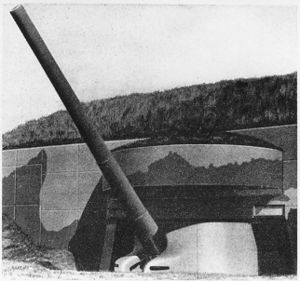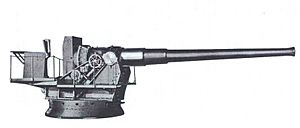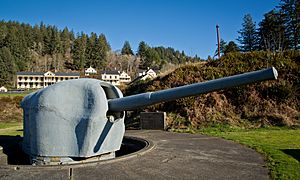Fort Church (Rhode Island) facts for kids
Quick facts for kids Fort Church |
|
|---|---|
| Part of Harbor Defenses of Narragansett Bay | |
| Little Compton, Rhode Island | |
|
Location in Rhode Island
|
|
| Coordinates | 41°28′46″N 71°11′00″W / 41.47944°N 71.18333°W |
| Type | Coastal Defense |
| Site information | |
| Owner | various |
| Controlled by | various |
| Condition | mostly buried |
| Site history | |
| Built | 1942 |
| Built by | United States Army |
| In use | 1942—1948 |
| Battles/wars | World War II |
Fort Church was a special fort built by the United States Army during World War II. It was located in Little Compton, Rhode Island. This fort was a key part of the Harbor Defenses of Narragansett Bay. Its main job was to protect the important Narragansett Bay from enemy attacks by sea.
Together with Fort Greene near Point Judith, Fort Church had the newest and most powerful guns. These new forts replaced older defenses that were not strong enough for modern warfare.
Why Fort Church Was Built
Fort Church was built starting in 1940. This was when World War II began in Europe and countries like France were being invaded. The United States realized it needed stronger defenses for its coasts.
The fort was named after Colonel Benjamin Church. He lived a long time ago (1639–1718) and is known as an early leader of what would become the United States Army Rangers. He is buried in Little Compton, where the fort was built.
The main goal was to replace old guns, some more than 35 years old, with powerful new ones. These new guns included very long-range 16"/50 caliber Mark 2 guns. Smaller guns were replaced with 6-inch guns that could fire at high angles.
To protect these big guns and their ammunition, they were placed inside strong concrete bunkers called "casemates." This protected them from air attacks. Fort Church also had a rare battery of 8-inch guns that were also protected in casemates.
Protecting Narragansett Bay
Fort Church was designed to guard the waterways leading into Narragansett Bay. This included the eastern part of the bay, known as the Sakonnet River. It worked with Fort Greene on the other side of the bay to create a strong defense.
The land for Fort Church was bought between 1939 and 1942. It was first called the Sakonnet Point Military Reservation. The fort was divided into three main areas:
- The North Reservation was at the Sakonnet Golf Club. It had Battery Gray (also called Battery Construction Number 107) with two 16-inch guns.
- The East Reservation was near Briggs Marsh. It held Battery Reilly, which had two 8-inch guns in casemates.
- The South Reservation was close to Sakonnet Point. This area had Battery Construction Number 212 with two 6-inch guns. It also had two "Panama mounts," which were circular concrete platforms for mobile 155 mm guns.
Battery Gray was named after Major Quinn Gray. Battery Reilly was named after Captain Henry J. Reilly (1845–1900), a brave soldier.
End of Fort Church
After World War II ended in 1945, the need for coastal defense forts like Fort Church decreased. In 1948, the guns at Fort Church were removed and scrapped. This happened to almost all other US coast artillery weapons at that time.
Fort Church Today
Today, the areas where the batteries of Fort Church once stood have been covered up or built over. There are no visible remains of the fort's powerful guns.





